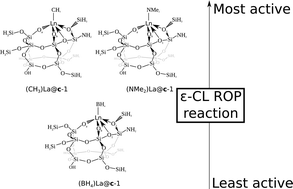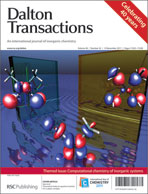The influence of the initiator ligand on the Ring Opening Polymerization (ROP) of ε-caprolactone by lanthanide complexes grafted on silica have been investigated by means of density functional theory (DFT) calculations. Three different initiator ligands (alkyl, dialkylamido and borohydride) and three grating modes (mono-grafted, bi-grafted or bi-grafted after breaking of a Si–O–Si bridge) have been considered. This study highlights that lanthanum grafted complexes (alkyl, amide or borohydride) are active in lactone polymerization. In any case the reaction process is demonstrated to be similar to the one found for homogeneous catalysts. However, even if the different grafting modes are energetically equivalent for the ε-caprolactone ROP initiation reaction, some differences are observed according to the ligand involved in the initiation reaction. In agreement with experimental data, grafted lanthanide amides rapidly polymerise the ε-caprolactone. The grafted alkyl lanthanum complexes are also predicted to be very efficient catalysts. The borohydride is thus predicted to be the least efficient due to the difficulties in the ring opening. Indeed, the rate-determining step is the nucleophilic attack for the methyl and dialkylamido ligands (occuring with a low barrier) whereas it is the ring opening for the borohydride ligands (highest barrier) and the formation of –CH2C(![[double bond, length as m-dash]](https://www.rsc.org/images/entities/char_e001.gif) O)(X) (X = CH3 or NMe2) terminal group is more favorable than that of a –CH2OBH2 end group.
O)(X) (X = CH3 or NMe2) terminal group is more favorable than that of a –CH2OBH2 end group.

You have access to this article
 Please wait while we load your content...
Something went wrong. Try again?
Please wait while we load your content...
Something went wrong. Try again?
![[double bond, length as m-dash]](https://www.rsc.org/images/entities/char_e001.gif) O)(X) (X = CH3 or NMe2) terminal group is more favorable than that of a –CH2OBH2 end group.
O)(X) (X = CH3 or NMe2) terminal group is more favorable than that of a –CH2OBH2 end group.

 Please wait while we load your content...
Please wait while we load your content...